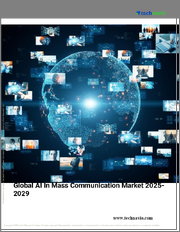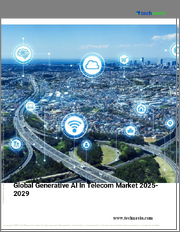
|
시장보고서
상품코드
1404573
통신용 AI 시장 규모, 점유율, 동향 분석 보고서 : 용도별, 지역별, 부문별 예측(2023-2030년)AI In Telecommunication Market Size, Share & Trends Analysis Report By Application (Network Security, Network Optimization, Customer Analytics, Virtual Assistance, Self-Diagnostics), By Region, And Segment Forecasts, 2023 - 2030 |
||||||
통신용 AI 시장 성장과 동향:
Grand View Research, Inc의 최신 보고서에 따르면, 세계 통신용 AI 시장 규모는 2030년까지 112억 9,000만 달러에 달할 것으로 예상됩니다.
이 시장은 2023년부터 2030년까지 28.2%의 CAGR을 기록할 것으로 예상됩니다.
통신 서비스 제공업체(CSP)는 네트워크 기능 가상화(NFV) 및 소프트웨어 정의 광역 네트워킹(SD-WAN)과 같은 새로운 기술 패러다임의 도입으로 인한 통신 네트워크의 복잡성에 대응하기 위해 시스템 최적화, 계획 및 운영에 인텔리전스를 도입해야 합니다. 도입해야 합니다. 이에 따라 통신 업계는 네트워크 효율성과 고객 경험을 개선하기 위해 AI를 탐구하고 도입하고 있습니다.
통신 업계는 클라우드 컴퓨팅, 빅데이터 분석, 딥러닝 등 기술을 활용해 멀티미디어 서비스와 네트워크 보안에 대한 소비자의 요구를 충족시키고 있습니다. 또한 서비스 인식 네트워크 시스템 및 심층 패킷 검사 기술의 발명으로 통신 네트워크의 지능화가 가능해졌습니다. 업계 연구자들은 인공지능 기반 기술을 활용해 네트워크 아키텍처와 관리를 최적화하고 보다 자율적인 운영을 가능하게 하고 있습니다.
또한, 차세대 무선 네트워크는 다양해지는 서비스 요구사항과 디바이스, 시스템 아키텍처, 애플리케이션의 이질성으로 인해 더욱 복잡한 시스템 아키텍처로 진화할 것으로 예상됩니다. 네트워크 기술이 복잡해짐에 따라 인공지능은 통신 업계에서 다시금 주목받고 있습니다. 통신 네트워크의 AI 기반 사용 사례로는 네트워크 운영 모니터링 및 관리, 부정행위 감소, 예지보전, 사이버 보안, 마케팅 및 고객 서비스를 위한 가상 비서 등을 꼽을 수 있습니다. 그러나 일부 통신 서비스 제공업체들이 통신 자동화 및 민첩성 요구에 대응하기 위해 AI 접근 방식을 채택하고 있기 때문에 네트워크 운영 모니터링 및 관리는 여전히 통신 업계에서 가장 중요한 사용 사례로 꼽히고 있습니다.
통신용 AI 시장 보고서 하이라이트
- 고객 서비스를 위해 도입된 챗봇이 사업 수익을 충분히 촉진하고 있기 때문에 고객 경험의 개선은 시장 성장을 촉진하는 주요 요인 중 하나입니다.
- 통신 분야에서는 가상화 문제를 해결하기 위한 머신러닝 접근법이 등장하기 시작했습니다.
- AI가 지원하는 네트워크 중심 애플리케이션에는 유지보수 및 프로비저닝을 위한 이상 감지, 성능 모니터링, 경고 억제, 문제 티켓 자동 해결, 네트워크 장애 예측, 네트워크 용량 계획 및 혼잡도 예측 등이 포함됩니다.
- 아시아태평양은 예측 기간 동안 가장 빠른 CAGR 32.9%로 성장할 것으로 예상됩니다. 이러한 성장은 중국과 인도와 같은 신흥국의 급속한 기술 발전에 기인합니다.
목차
제1장 조사 방법과 범위
제2장 주요 요약
제3장 통신용 AI 시장 변수, 동향, 범위
- 시장 계통 전망
- 업계의 밸류체인 분석
- 시장 역학
- 시장 성장 촉진요인 분석
- 시장 성장 억제요인 분석
- 시장 기회 분석
- 통신 시장 분석 툴의 인공지능
- 업계 분석 - Porter's Five Forces 분석
- PESTEL 분석
제4장 통신용 AI 시장 : 용도 추정·동향 분석
- 통신용 AI 시장 : 중요한 포인트
- 통신용 AI 시장 : 동향과 시장 점유율 분석, 2022년 및 2030년
- 네트워크 보안
- 네트워크 최적화
- 고객 분석
- 가상 어시스턴스
- 자가 진단
- 기타
제5장 통신용 AI 시장 : 지역 추정·동향 분석
- 지역별 전망
- 지역별 통신용 AI 시장 : 중요한 포인트
- 북미
- 시장 추정과 예측, 2017년에서 2030년까지
- 미국
- 캐나다
- 유럽
- 영국
- 독일
- 프랑스
- 아시아태평양
- 일본
- 중국
- 인도
- 호주
- 한국
- 라틴아메리카
- 브라질
- 멕시코
- 중동 및 아프리카
- 사우디아라비아
- 남아프리카공화국
- 아랍에미리트
제6장 경쟁 상황
- 주요 시장 진출 기업에 의한 최근의 동향과 영향 분석
- 시장 진출 기업 분류
- IBM Corporation
- Microsoft
- Intel Corporation
- Google LLC
- AT&T Intellectual Property
- Cisco Systems, Inc.
- Nuance Communications, Inc.
- Evolv Technologies Holdings Inc.
- H2O.ai.
- Infosys Limited
- Salesforce, Inc.
- NVIDIA Corporation
AI In Telecommunication Market Growth & Trends:
The global AI in telecommunication market size is expected to reach USD 11.29 billion by 2030, according to a new report by Grand View Research, Inc. The market is anticipated to register a CAGR of 28.2% from 2023 to 2030.
Communication Service Providers (CSPs) need to bring the intelligence in their system optimization, planning, and operations to address the increasing complexities in communication networks caused due to the deployment of new technology paradigms, such as Network Function Virtualization (NFV) and Software-Defined Wide-Area Networking (SD-WAN). Therefore, the telecommunications industry is exploring and introducing AI to improve network efficiency and customer experience.
The telecommunication industry has leveraged technologies, such as cloud computing, big data analytics, and deep learning, to fulfill consumer demands of multimedia services and network security. Also, the intellectualization of communication networks has become possible with the invention of technologies of service-aware network systems and deep packet inspection. Researchers in the industry are tapping into artificial intelligence-based techniques to optimize network architecture & management, and to enable more autonomous operations.
Furthermore, the next-generation wireless networks are anticipated to evolve into more complex system architectures due to the diversified service requirements and heterogeneity in devices, system architectures, and applications. Artificial intelligence has renewed interest in the telecom industry due to the rising complexity of network technology. Potential AI-based use-cases in communication networks include network operation monitoring & management, fraud mitigation, predictive maintenance, cybersecurity, and virtual assistants for marketing and customer service. However, network operation monitoring & management remains the top use-case in the telecom industry as several communications service providers have adopted AI approaches to address the need for communication automation and agility.
AI In Telecommunication Market Report Highlights:
- Improving customer experience is one of the major factors driving the growth of the market since chatbots deployed for customer service have fueled the business earnings adequately
- Machine learning approaches are beginning to emerge in the telecommunication domain to address the challenges of virtualization
- AI-supported network-centric applications include anomaly detection for maintenance and provisioning, performance monitoring, alert suppression, automated resolution of a trouble ticket, network faults prediction, and network capacity planning or congestion prediction
- Asia Pacific is expected to grow at the fastest CAGR of 32.9% during the forecast period. This growth is attributed to the rapid technological advancements in emerging economies, such as China and India.
Table of Contents
Chapter 1. Methodology and Scope
- 1.1. Market Segmentation & Scope
- 1.1.1. Application
- 1.1.2. Regional scope
- 1.1.3. Estimates and forecast timeline
- 1.2. Research Methodology
- 1.3. Information Procurement
- 1.3.1. Purchased database
- 1.3.2. GVR's internal database
- 1.3.3. Secondary sources
- 1.3.4. Primary research
- 1.3.5. Details of primary research
- 1.4. Information or Data Analysis
- 1.5. Market Formulation & Validation
- 1.6. Model Details
- 1.7. List of Secondary Sources
- 1.8. List of Primary Sources
- 1.9. Objectives
Chapter 2. Executive Summary
- 2.1. Market Outlook
- 2.2. Segment Outlook
- 2.2.1. Application outlook
- 2.2.2. Regional outlook
- 2.3. Competitive Insights
Chapter 3. Artificial Intelligence in Telecommunication Market Variables, Trends & Scope
- 3.1. Market Lineage Outlook
- 3.2. Industry Value Chain Analysis
- 3.3. Market Dynamics
- 3.3.1. Market driver analysis
- 3.3.2. Market restraint analysis
- 3.3.3. Market opportunity analysis
- 3.4. Artificial Intelligence in Telecommunication Market Analysis Tools
- 3.4.1. Industry analysis - Porter's
- 3.4.1.1. Supplier power
- 3.4.1.2. Buyer power
- 3.4.1.3. Substitution threat
- 3.4.1.4. Threat of new entrant
- 3.4.1.5. Competitive rivalry
- 3.4.2. PESTEL analysis
- 3.4.2.1. Political landscape
- 3.4.2.2. Technological landscape
- 3.4.2.3. Economic landscape
- 3.4.1. Industry analysis - Porter's
Chapter 4. Artificial Intelligence in Telecommunication Market: Application Estimates & Trend Analysis
- 4.1. Artificial Intelligence in Telecommunication Market: Key Takeaways
- 4.2. Artificial Intelligence in Telecommunication Market: Movement & Market Share Analysis, 2022 & 2030
- 4.3. Network Security
- 4.3.1. Network security market estimates and forecasts, 2017 to 2030 (USD Million)
- 4.4. Network optimization
- 4.4.1. Network optimization market estimates and forecasts, 2017 to 2030 (USD Million)
- 4.5. Customer Analytics
- 4.5.1. Customer analytics market estimates and forecasts, 2017 to 2030 (USD Million)
- 4.6. Virtual Assistance
- 4.6.1. Virtual assistance therapy market estimates and forecasts, 2017 to 2030 (USD Million)
- 4.7. Self-Diagnostics
- 4.7.1. Self-Diagnostics market estimates and forecasts, 2017 to 2030 (USD Million)
- 4.8. Others
- 4.8.1. Others market estimates and forecasts, 2017 to 2030 (USD Million)
Chapter 5. Artificial Intelligence in Telecommunication Market: Regional Estimates & Trend Analysis
- 5.1. Regional Outlook
- 5.2. Artificial Intelligence in Telecommunication Market by Region: Key Takeaway
- 5.3. North America
- 5.3.1. Market estimates and forecasts, 2017 to 2030 (Revenue, USD Million)
- 5.3.2. U.S.
- 5.3.2.1. Market estimates and forecasts, 2017 to 2030 (Revenue, USD Million)
- 5.3.3. Canada
- 5.3.3.1. Market estimates and forecasts, 2017 to 2030 (Revenue, USD Million)
- 5.4. Europe
- 5.4.1. UK
- 5.4.1.1. Market estimates and forecasts, 2017 to 2030 (Revenue, USD Million)
- 5.4.2. Germany
- 5.4.2.1. Market estimates and forecasts, 2017 to 2030 (Revenue, USD Million)
- 5.4.3. France
- 5.4.3.1. Market estimates and forecasts, 2017 to 2030 (Revenue, USD Million)
- 5.4.1. UK
- 5.5. Asia Pacific
- 5.5.1. Japan
- 5.5.1.1. Market estimates and forecasts, 2017 to 2030 (Revenue, USD Million)
- 5.5.2. China
- 5.5.2.1. Market estimates and forecasts, 2017 to 2030 (Revenue, USD Million)
- 5.5.3. India
- 5.5.3.1. Market estimates and forecasts, 2017 to 2030 (Revenue, USD Million)
- 5.5.4. Australia
- 5.5.4.1. Market estimates and forecasts, 2017 to 2030 (Revenue, USD Million)
- 5.5.5. South Korea
- 5.5.5.1. Market estimates and forecasts, 2017 to 2030 (Revenue, USD Million)
- 5.5.1. Japan
- 5.6. Latin America
- 5.6.1. Brazil
- 5.6.1.1. Market estimates and forecasts, 2017 to 2030 (Revenue, USD Million)
- 5.6.2. Mexico
- 5.6.2.1. Market estimates and forecasts, 2017 to 2030 (Revenue, USD Million)
- 5.6.1. Brazil
- 5.7. MEA
- 5.7.1. Saudi Arabia
- 5.7.1.1. Market estimates and forecasts, 2017 to 2030 (Revenue, USD Million)
- 5.7.2. South Africa
- 5.7.2.1. Market estimates and forecasts, 2017 to 2030 (Revenue, USD Million)
- 5.7.3. UAE
- 5.7.3.1. Market estimates and forecasts, 2017 to 2030 (Revenue, USD Million)
- 5.7.1. Saudi Arabia
Chapter 6. Competitive Landscape
- 6.1. Recent Developments & Impact Analysis, By Key Market Participants
- 6.2. Market Participant Categorization
- 6.2.1. IBM Corporation
- 6.2.1.1. Company overview
- 6.2.1.2. Financial performance
- 6.2.1.3. Product benchmarking
- 6.2.1.4. Strategic initiatives
- 6.2.2. Microsoft
- 6.2.2.1. Company overview
- 6.2.2.2. Financial performance
- 6.2.2.3. Product benchmarking
- 6.2.2.4. Strategic initiatives
- 6.2.3. Intel Corporation
- 6.2.3.1. Company overview
- 6.2.3.2. Financial performance
- 6.2.3.3. Product benchmarking
- 6.2.3.4. Strategic initiatives
- 6.2.4. Google LLC
- 6.2.4.1. Company overview
- 6.2.4.2. Financial performance
- 6.2.4.3. Product benchmarking
- 6.2.4.4. Strategic initiatives
- 6.2.5. AT&T Intellectual Property
- 6.2.5.1. Company overview
- 6.2.5.2. Financial performance
- 6.2.5.3. Product benchmarking
- 6.2.5.4. Strategic initiatives
- 6.2.6. Cisco Systems, Inc.
- 6.2.6.1. Company overview
- 6.2.6.2. Financial performance
- 6.2.6.3. Product benchmarking
- 6.2.6.4. Strategic initiatives
- 6.2.7. Nuance Communications, Inc.
- 6.2.7.1. Company overview
- 6.2.7.2. Financial performance
- 6.2.7.3. Product benchmarking
- 6.2.7.4. Strategic initiatives
- 6.2.8. Evolv Technologies Holdings Inc.
- 6.2.8.1. Company overview
- 6.2.8.2. Financial performance
- 6.2.8.3. Product benchmarking
- 6.2.8.4. Strategic initiatives
- 6.2.9. H2O.ai.
- 6.2.9.1. Company overview
- 6.2.9.2. Financial performance
- 6.2.9.3. Product benchmarking
- 6.2.9.4. Strategic initiatives
- 6.2.10. Infosys Limited
- 6.2.10.1. Company overview
- 6.2.10.2. Financial performance
- 6.2.10.3. Product benchmarking
- 6.2.10.4. Strategic initiatives
- 6.2.11. Salesforce, Inc.
- 6.2.11.1. Company overview
- 6.2.11.2. Financial performance
- 6.2.11.3. Product benchmarking
- 6.2.11.4. Strategic initiatives
- 6.2.12. NVIDIA Corporation
- 6.2.12.1. Company overview
- 6.2.12.2. Financial performance
- 6.2.12.3. Product benchmarking
- 6.2.12.4. Strategic initiatives
- 6.2.1. IBM Corporation
(주말 및 공휴일 제외)


















